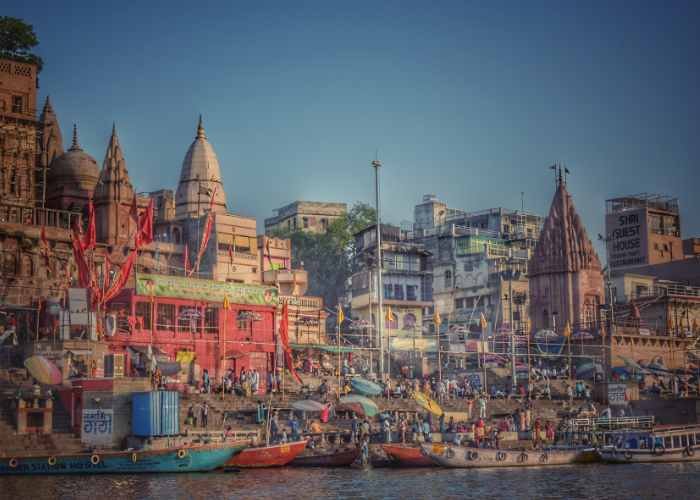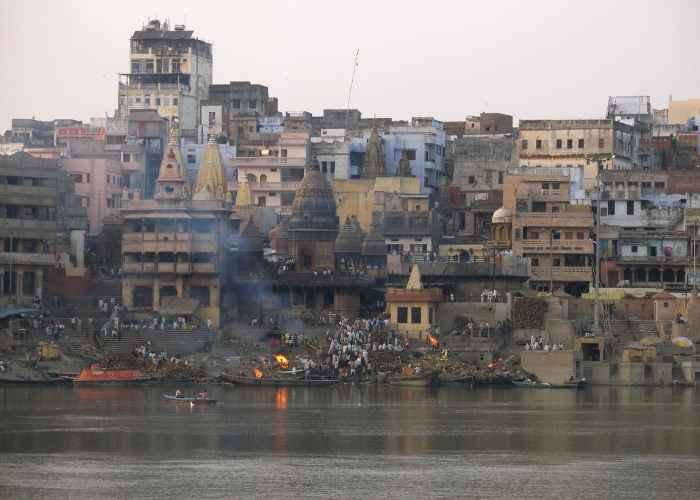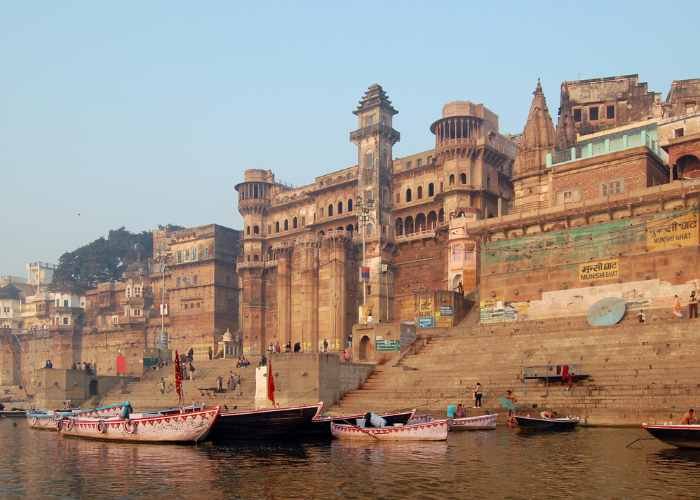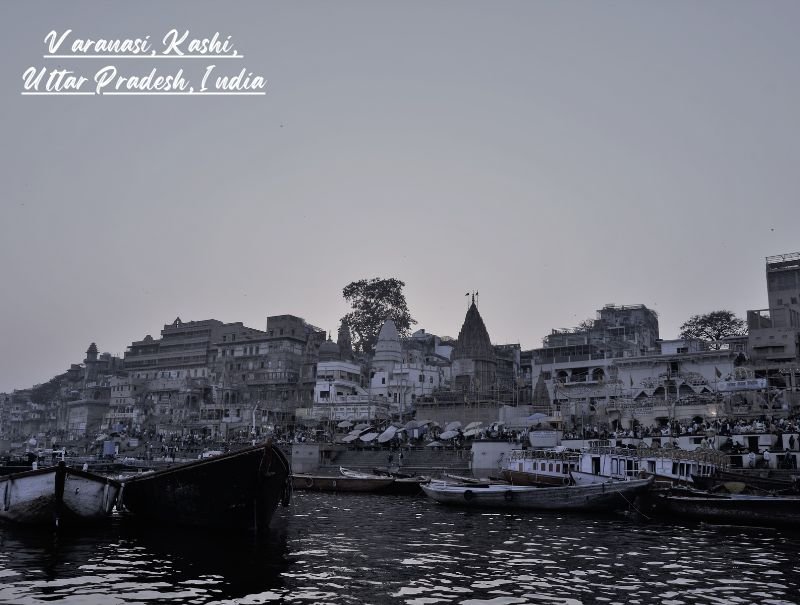Top places to visit in Varanasi. Let’s explore the rich history of the world’s oldest city Varanasi which is also known as Benares or Kashi, and holds a central place in the traditions of pilgrimage, death, and mourning in the Hindu world.
Table of Contents
Top places to visit in Varanasi: Let’s explore this historic city’s interesting history

Top places to visit in Varanasi with friends
- Varanasi is one of the world’s oldest continually inhabited cities. 2,500 years ago, a kingdom with the same name was connected to its ancient name, Kashi.
- The city lies on the left bank of the Ganges river in the middle Ganges valley in the southeastern part of the state of Uttar Pradesh.
- It is 692 kilometers (430 miles) southeast of India’s capital, New Delhi, and 320 kilometers (200 miles) southeast of the state capital, Lucknow.
- Varanasi is situated 121 kilometers (75 miles) downstream of Prayagraj, where the confluence with the Yamuna river forms another major Hindu pilgrimage site.
Spiritual Significance
- Lord Shiva is deeply associated with Varanasi. According to legend, it is the place where Lord Shiva and Goddess Parvati founded the universe.
- Lord Rama, after defeating the demon king Ravana, is believed to have performed penance here
- Varanasi may also have been a battlefield in the Mahabharata, where Lord Krishna set fire to an imposter Krishna.
Cultural and Literary Legacy
- In the eighth century, Adi Shankara made the worship of Shiva an official sect in Varanasi.
- Tulsidas wrote the epic Ramcharitmanas in the Awadhi language; it is a notable piece of literature connected to Varanasi.
- This holy city was the birthplace of Kabir and Ravidas, two more prominent Bhakti movement stalwarts.
Architectural Structure
- In the 16th century, Rajput nobles sponsored the building and enhancement of major Shiva temples in Varanasi, displaying an empire-wide architectural style is Top places to visit in Varanasi.
- The right next to Sarnath, the Lion Capital of Ashoka, is said to be a memorial to the Buddha’s first speech delivered there in the fifth century BCE.
- Varanasi’s rich tapestry of spirituality, culture, and history continues to captivate visitors from around the world.
What is the best time to visit Varanasi?
Top places to visit in Varanasi depend on the best time to visit Varanasi depends on your preferences and the experiences you seek. Let me guide you:
Winter (October to February)
Ideal for most travelers: The weather is pleasant, with temperatures ranging from 12°C to 25°C (54°F to 77°F).
Festivals: Witness the Ganga Mahotsav and Dev Deepawali celebrations during November.
Spiritual Atmosphere: The cool weather enhances the spiritual ambiance of the ghats and temples.
Summer (March to June)
Hot and Humid: Temperatures soar, reaching up to 40°C (104°F) in April and May.
Spiritual Practices: Despite the heat, pilgrims continue their rituals along the Ganges.
Avoid peak summer unless you’re comfortable with high temperatures.
Monsoon (July to September)
Rainy Season: Varanasi experiences heavy rainfall during this period.
Ghats and River: The Ganges swells, and the ghats become slippery.
Spiritual Significance: Some believe that visiting during the monsoon brings blessings.
Post-Monsoon (October to November)
Transitional Weather: As the monsoon recedes, the weather becomes pleasant.
Festivals: Attend the Durga Puja and Diwali celebrations.
Photography: Capture the city’s vibrant colors and festivities.
Remember that Varanasi’s spiritual energy remains constant throughout the year. Choose a time that aligns with your preferences and interests.
Top places to visit in Varanasi?
Certainly! Varanasi boasts a rich tapestry of ghats, each with its own unique significance. These are the Top places to visit in Varanasi
Assi Ghat is the Top places to visit in Varanasi
- Located at the southern end of the city, Assi Ghat is where the Ganges River meets the Assi River is the Top places to visit in Varanasi.
- Pilgrims bathe here before worshiping Lord Shiva in the form of a huge lingam under a pipal tree is the Top places to visit in Varanasi.
- Trendy boutiques and cafes add to its charm, making it a favorite spot for long-staying travelers.
Dashashwamedh Ghat
- Heart of the action and the top attraction and Top places to visit in Varanasi.
- Ganga aarti takes place here every evening, creating a mesmerizing spectacle.
- According to Hindu mythology, Lord Brahma created this ghat to welcome Lord Shiva.
Manikarnika Ghat

- Known as the cremation ghat, it is where the last rites are performed is also Top places to visit in Varanasi.
- Hindus believe that cremation here leads to moksha (liberation from the cycle of rebirth).
- A place of intense spiritual energy and reflection.
Harishchandra Ghat
- Another significant cremation ghat alongside the Ganges is the Top places to visit in Varanasi.
- Named after King Harishchandra, who exemplified truth and sacrifice.
- Witnessing the rituals here is a profound experience.
Chet Singh Ghat
- Top places to visit in Varanasi is historically important due to an 18th-century battle between Maharaja Chet Singh and the British.
- Chet Singh’s small fort, captured by the British, adds intrigue to this ghat is the Top places to visit in Varanasi.

Darbhanga Ghat is Top places to visit in Varanasi
- Architecturally impressive and photogenic.
- Features the luxury Brij Rama Palace hotel, originally a fort.
- King Rameshwar Singh Bahadur of Darbhanga transformed it into his palace is the Top places to visit in Varanasi.
- Remember, these ghats are not just physical structures; they embody centuries of history, spirituality, and devotion.
How do I participate in a Ganga Aarti ceremony at Dashashwamedh Ghat?
Top places to visit in Varanasi is participating in the Ganga Aarti ceremony at Dashashwamedh Ghat in Varanasi is a deeply spiritual and memorable experience. Here’s how you can be part of this ancient ritual:
Timing and Location
- Top places to visit in Varanasi is the Ganga Aarti takes place every evening at dusk, just after sunset is the Top places to visit in Varanasi.
- Head to Dashashwamedh Ghat, one of the most iconic ghats in Varanasi, located on the banks of the Ganges River.
Arrive Early
- Arrive at the ghat well before the scheduled time to secure a good spot.
- The ghat gets crowded, especially during festivals and peak tourist seasons.
Observing the Aarti
- Find a place along the ghat where you can see the priests clearly.
- The priests, dressed in saffron robes, perform the Aarti with large brass lamps filled with ghee (clarified butter).
- They chant mantras and wave the lamps in a rhythmic motion around a central fire.
Joining the Aarti
- If you wish to actively participate, stand near the priests.
- Fold your hands in prayer and join them in chanting the mantras.
- Feel the energy and devotion as you offer your gratitude to the Ganges for nurturing life.
Boat Option
- Alternatively, you can hire a boat and watch the Aarti from the river.
- Boatmen position their boats right in front of the Aarti benches, allowing tourists to witness the spectacle from the water.
Photography and Respect
- If you’re interested in capturing the moment, consider taking a boat.
- However, if you want a more personal experience, stand alongside the priests and pray sincerely.
- Remember that this is a sacred ritual, so maintain reverence and respect.
Symbolism
- The Aarti represents the light of knowledge and purity.
- The lamps symbolize the illumination of the mind and the purification of the soul.
- The conch shell blown at the beginning signifies the elimination of negative energy.
Feel the Spirituality
- As the lamps sway, feel the connection with the ancient tradition of river worship.
- Let the chants and the flickering flames transport you to a deeper spiritual realm.
The Ganga Aarti at Dashashwamedh Ghat is not just a visual spectacle; it’s an opportunity to connect with the divine and experience the timeless flow of devotion.
How much does it cost to hire a boat for Ganga Aarti?
Top places to visit in Varanasi is to watch Ganga Aarti. The cost of hiring a boat for the Ganga Aarti ceremony in Varanasi can vary based on factors such as the type of boat, the number of passengers, and the specific ghat from which you depart. Here are some approximate rates:
The cost of hiring a boat for the Ganga Aarti ceremony in Varanasi can vary based on factors such as the type of boat, the number of passengers, and the specific ghat from which you depart. Here are some approximate rates:
Private Motor Boat (1-6 persons)
Assi Ghat to Manikarnika Ghat: ₹2,9991.
Assi Ghat to NAMO Ghat (50 ghats): ₹3,4991.
Private Bajra Boat (1-30 persons):
Assi Ghat to NAMO Ghat (all 84 ghats): ₹10,0001.
Shared Boats
Shared boats are more affordable but won’t guarantee front-row seating.
Traditional row boats provide an authentic experience, while motorized boats cover more distance on the river.
Rates for Shared Boats
Expect to pay around ₹500-600 per person for a 1-hour shared boat ride1.
Private Boats
A private boat for up to 4 people will cost approximately ₹1,500-2,000 total.
Discuss your preferences with the boatman to choose the right vessel.
Booking Options
You can book directly with local boat operators at the ghats.
Alternatively, consider booking online through tour companies before your arrival.
Voxplor Tips
Wear modest clothing out of respect for local culture (no shorts or tank tops).
Bring a scarf or cap to stay warm after sunset.
Remember, witnessing the Ganga Aarti from a boat on the river is a magical experience that allows you to immerse yourself in the mystical aura of Varanasi.
Can you recommend any good hotels near Dashashwamedh Ghat?
Certainly! When you’re near Dashashwamedh Ghat in Varanasi, you’ll find a delightful array of hotels to choose from. Here are some Voxplor recommendations:
BrijRama Palace
Location: Dashashwamedh Ghat Road, Near Sri Sri Ma Ganga Mandir, Bangali Tola, Varanasi.
Features: This heritage hotel offers 32 guestrooms with minibars and flat-screen televisions. It’s right by the Kashi Vishwanath Temple1.
Palace On Steps
Location: Situated directly on the banks of the Ganges River, it’s accessible only on foot (10 minutes from the road).
Highlights: Rooftop restaurant, 24-hour room service, and free Wi-Fi. Rooms offer river views2.
Sri Omkar Palace
Location: D21/10 Chausatthi Ghat, Varanasi.
Features: Rooms with flat-screen TVs, air conditioning, and private bathrooms. Enjoy a continental or vegetarian breakfast.
Hotel Lara India
Location: Dashashwamedh Ghat Road, Near Shri Shri Shava Shiva Kali Mandir, Bangali Tola, Varanasi.
Amenities: Free Wi-Fi, room service, and an on-site restaurant. Close to landmarks like Manikarnika Ghat and Banaras Ghats.
Remember to choose a hotel that aligns with your preferences and allows you to immerse yourself in the spiritual and cultural vibes of Varanasi.
How do I get from Varanasi airport to my hotel?
Certainly! When arriving at Lal Bahadur Shastri Airport in Varanasi, you have several transportation options to reach your hotel near Dashashwamedh Ghat:
Prepaid Taxi Service
Vidhan Travels offers prepaid taxi services from the airport to various destinations in Varanasi.
Choose from a range of cars, including Mini Cab, Micro Cab, Sedan Car, SUVs, and even luxury Sedan Cars like BMW and Audi.
Prices start at ₹900 for airport pickup and drop-off.
Shared Taxis and Private Cars
Shared taxis are available at the airport, but for more comfort and convenience, consider booking a private taxi.
Reliable operators like Vidhan Travels provide chauffeur-driven cars for airport transfers.
Bus Stand
If you’re on a tight budget, there’s a bus stand about a 10-minute walk from the airport terminal.
Public and privately operated buses connect the airport to Varanasi city center.
Car Rentals
Car rental services are available within the airport premises.
Check the condition of the car before booking.
Voxplor Tips for a Smooth Journey
- Book in advance to avoid waiting and bargaining.
- Choose a reliable operator with good reviews and necessary permits.
- Confirm your destination, fare, and any additional charges.
- Carry identification documents and cab booking details.
Remember to choose the option that best suits your preferences and enjoy your stay in Varanasi!
Frequently Asked Questions (FAQs)
What is Varanasi famous for?
Varanasi is famous for its spiritual significance and is considered one of the holiest cities in India.
Which God is famous in Varanasi?
Lord Shiva.
Which industry is famous in Varanasi?
The textile industry is famous in Varanasi.
What is famous in Varanasi for eating?
Some famous foods in Varanasi are kachori, chaat, lassi, thandai, and paan.
How can I spend 1 day in Varanasi?
To make the most of a day in Varanasi, you can:
Begin your day at sunrise with a boat ride along the Ganges River to witness the morning rituals and ceremonies.
Explore the narrow lanes of the Old City, visiting iconic temples like shri kashi vishwanath temple and Sankat Mochan Hanuman Temple.
Experience the spiritual side of Varanasi by attending an Aarti ceremony at the ghats, such as Dashashwamedh Ghat or Assi Ghat.
Visit the Banaras Hindu University to see the Bharat Kala Bhavan Museum and the New Vishwanath Temple.
Enjoy the local cuisine by trying famous dishes like kachori, lassi, and paan.
Witness the evening Ganga Aarti, a mesmerizing ritual that takes place at the ghats.
End your day with a peaceful boat ride along the river, observing the illuminated ghats and the beauty of Varanasi by night.
More details visit: https://varanasi.nic.in/
Image by Pexels, Vyacheslav Argenberg, Dan Ruth, Marcin Białek, Edwin Lord Weeks, Saaremees, Dennis Jarvis
Also, Read My Next Blog On Booking Cheap Flight: Tips And Tricks On Your Travel
